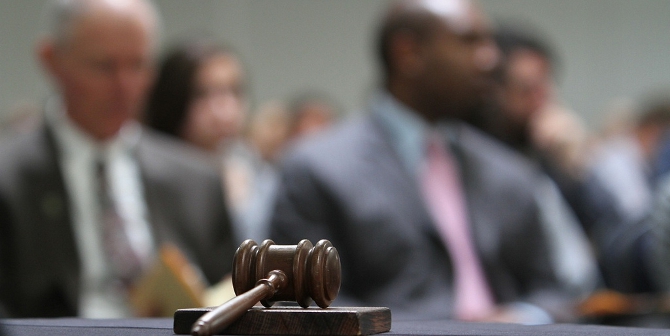
 The US imprisons thousands of children under the age of 18, and of these youth of color are disproportionately incarcerated. In new research, Courtney Echols and Nancy Rodriguez seek to better understand the role of probation officers’ recommendations in contributing to youth incarceration. They find that youth of color were more likely to be recommended for harsher treatment by probation officers, and that these recommendations were often informed by racial stereotypes and perceptions of alleged gang affiliation, mental health concerns, and ‘dangerousness’.
The US imprisons thousands of children under the age of 18, and of these youth of color are disproportionately incarcerated. In new research, Courtney Echols and Nancy Rodriguez seek to better understand the role of probation officers’ recommendations in contributing to youth incarceration. They find that youth of color were more likely to be recommended for harsher treatment by probation officers, and that these recommendations were often informed by racial stereotypes and perceptions of alleged gang affiliation, mental health concerns, and ‘dangerousness’.
Although the number of youth in US jails or prisons has declined in recent years, an estimated 60,000 children under the age of 18 are confined on any given day across the country. Moreover, youth of color have been and continue to be disproportionately incarcerated. Racial and ethnic minorities account for nearly 70 percent of all incarcerated youth, even though they make up only 49 percent of the adolescent population. Short of ending incarceration of youth altogether, ending the racial disparities within the juvenile justice system means that we need to have a better understanding of how those disparities are produced in court decision-making processes.
Probation Officers are key actors in Juvenile Court
Probation officers are key ‘actors’ in juvenile Court, as they function as the main point of contact between youth, families, and juvenile court judges. Often described as the workhorse of the juvenile justice system, probation staff serve as case managers, overseeing the intake, investigation, and supervision of youth. Probation officers are responsible for compiling case information via an investigative process and making recommendations to the court regarding individuals’ legal status, including their detention and release. The recommendations and actions that probation officers make are often hidden, yet important in juvenile justice processes.
Discretion is key in probation officers’ recommendation decisions. They must weigh an array of factors, including the delinquent act, its circumstances, and available options for treatment or punishment. Probation officers differ in their orientation toward treatment and punishment, as there is no “one- size-fits-all” justice ideology among officers. Given the various duties probation officers perform, and their involvement in detention processing, their recommendations to the court and factors that shape their decisions warrant closer examination.
What do we know about Court actors’ decisions?
Court actors’ decisions are influenced by three main concerns that include protection of the community, blameworthiness, and practical constraints (e.g., youths “ability to do time,” institutional resources, and familial ties). To manage these competing interests, coupled with limited information, court actors may employ racial stereotypes as a sort of “perceptual shorthand.” Racial disparities in youth justice outcomes are in part, a reflection of the interaction between stereotypes and focal concerns.
In new research, we examined racial disparities in probation officers’ recommendations to the court as to whether youth should remain detained or committed, be released to a residential treatment facility, or be released home. We also assessed how key features in the lives of youth, including mental health concerns, alleged gang affiliation, family challenges, and perceived danger to others impact probation officers’ recommendations.
Racial disparities in Probation Officers’ recommendations to the Court
We found that, all else being equal, youth of color were more likely to be recommended for more punitive treatment. Youth of color were less likely than their White counterparts to be recommended for residential treatment than to be recommended for release home, suggesting a differential allocation of treatment resources for youth. Compared to Whites, Native American youth were more likely to be recommended for detention/commitment than released home. We also found that youth with longer stays in detention were more likely to be recommended for continued detention/commitment or residential treatment than be recommended for release to the home. Our findings also suggest that mental health concerns, alleged gang affiliation, family challenges, and danger to others informed probation officers’ recommendations to the court.

“Juvenile Justice Center Sign” (CC BY 2.0) by Only in Oregon
The impact of mental health concerns among justice involved youth
Of all youth in the juvenile justice system, 70 percent have at least one mental health condition compared to 20 percent in the community. Mental health disorders have been linked to negative stereotypes, such as unpredictability and dangerousness. Further, Black youth with mental health disorders are more likely than other groups, with or without mental health problems, to receive the most severe sanctions. However, we found that mental health was only significant for White youth, as they were more likely to receive residential treatment over being released home. This suggests that while some youth receive the treatment they need, they are removed from the home to receive such care. Like others, we stress that specialized treatment is always best over a punitive response.
The impact of alleged gang affiliation label
Probation officers may discriminate between individuals who are allegedly gang affiliated and those who are not through focal concerns (e.g., youth viewed as more blameworthy, pose a greater safety risk to the community). Our findings bolster this research and suggest that alleged gang affiliation result in punitive recommendations by probation officers for youth disproportionately impacted by the label: Black, Latino, and Native youth. This suggests that alleged gang involved youth were deemed more blameworthy and a greater threat to the community, and therefore more deserving of punitive sanctions. Gang affiliation use in juvenile justice processes can produce racial disparities, especially when focusing on confined youth who are disproportionately youth of color.
Family factors
Court actors identify family functioning, including family support and cooperation, as most influential in informing court outcomes, and a history of family violence and involvement with child protective services are associated with severe outcomes. We found that family challenges only impacted probation officers’ recommendations for White youth. This suggests that while family information may have been more critical for White youth when making assessments, youths’ ability to do time and institutional resources may matter more for youth of color. This finding may also reflect previous research illustrating that court actors are more likely to attribute Black youths’ delinquency to internal factors (e.g., negative attitude or personality) and White youths’ delinquency to external factors (e.g., family factors).
Perceptions of dangerousness
Protection of the community from individuals deemed dangerous is a main concern among decision makers when deciding how to best dispose of a case. However, decision makers often do not have sufficient information to accurately assess dangerousness and therefore may develop a perceptual shorthand based on stereotypes or attributes that are frequently associated with factors such as race, age, and gender.
Although we found that characterizations of dangerousness appeared to be a strong factor in officers’ recommendations to the court and in continued confinement of all youth, Black youth, especially boys, have historically been perceived as more dangerous and not as worthy of “saving” as Whites. Black youth are still frequently stereotyped as dangerous, blameworthy, delinquent, and undisciplined. For example, Black youth have been described in court reports as a greater danger to the community and as less amenable to treatment. Latino and Native American youths’ marginalized status has also produced racialized stereotypes of dangerousness. Black youth and Latinos with criminal histories are viewed as more dangerous compared to Whites, and therefore, juvenile justice actors use of prior record to inform assessments of dangerousness can reproduce racial disparities.
Racial disparities in sentencing may flow from judges following the recommendations of Probation Officers
Probation officers, like other court actors, use racial stereotypes as a shorthand, reserving more punitive sanctions for youth of color. This suggests probation officers’ recommendations may play a significant role in (re)producing racial disparities. Further, judges often use probation officers’ reports in their final adjudication and sentencing decisions, and judicial sentences are often congruent with probation officers’ recommendations. Our findings suggest that racial disparities in sentencing may be the result of judges following the recommendations of probation officers. We recommend better understanding probation officers’ decisions and the factors that inform them, as a way to uncover how racial disparities are reinforced in the juvenile justice system.
- This article is based on the paper, ‘Who Should Go Home From Detention? The Racial and Ethnic Disparities in Probation Officers’ Recommendations to the Court’, in Crime & Delinquency
- Please read our comments policy before commenting.
- Note: This article gives the views of the author, and not the position of USAPP– American Politics and Policy, nor of the London School of Economics.
- Shortened URL for this post: https://bit.ly/3J6MPZT






